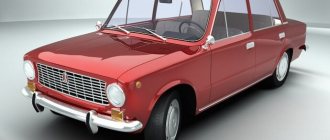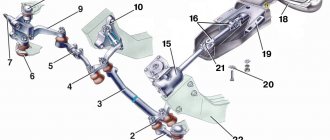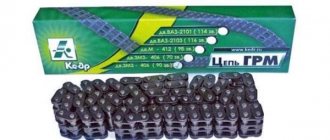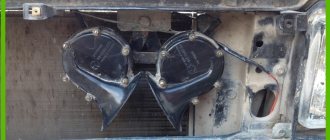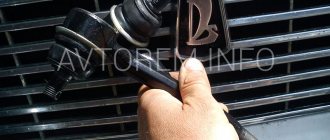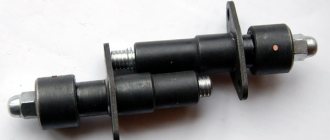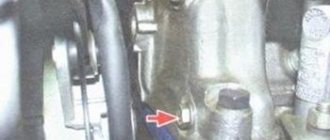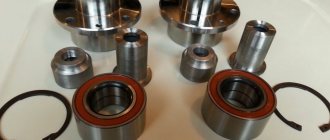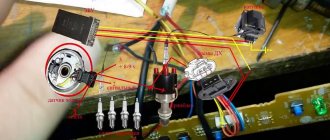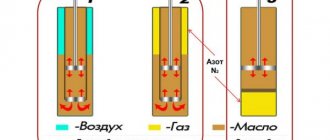A timing belt or chain is installed as a timing drive on different types of engines.
They transmit torque from the crankshaft to the camshaft, which controls the operation of the vehicle's valve system. The VAZ 2107 engines use a chain drive, which provides greater reliability compared to a belt drive. There are frequent cases of broken timing belts, which leads to damage to the valves of the gas distribution system and requires expensive, labor-intensive engine repairs. Unlike a belt, a timing chain guarantees the absence of breaks and the consequences associated with it. During operation, the chain gradually wears out and stretches, beginning to make an unpleasant knocking noise. If the malfunction is not corrected in time, a chain that is too loose can jump one or two teeth, which will lead to a shift in valve timing, loss of power and engine performance. If the chain slips by a larger number of teeth, the timing valves may “meet” the pistons, as happens on some engines when the timing belt breaks. To prevent this from happening, it is necessary to periodically monitor the tension and, if necessary, tighten the VAZ 2107 chain.
Timing chain drive VAZ 2107 - description
The VAZ 2107 timing chain transmission has a long service life, but someday it’s time to replace it. The need for this arises as a result of stretching of the links, when the chain tensioner can no longer cope with the functions assigned to it. In addition, the parts responsible for the normal operation of the timing drive also wear out over time.
The main elements of the VAZ 2107 timing drive are a chain, a damper, a shoe, a tensioner and sprockets
Tranquilizer
In the chain drive of the VAZ 2107 gas distribution mechanism, a damper is used to dampen jerks and vibrations of the chain. Without this part, as the vibration amplitude increases, the chain may fly off the gears or break completely. A chain transmission break is most likely at maximum crankshaft speed, which happens instantly. At the moment of a break, the intake and exhaust valves fail. After such damage, the engine will at best require a major overhaul.
The chain damper is designed to dampen vibrations of the chain drive during engine operation.
By its design, the damper is a plate made of high-carbon steel with two holes for fastening. Another element that is simultaneously responsible for calming and tensioning the chain is the shoe. Its rubbing surface is made of high-strength polymer material.
The tensioner shoe provides chain tension, eliminating sagging
Tensioner
Based on the name, you can understand that the device is designed to prevent sagging of the timing chain while the engine is running. There are several types of such mechanisms:
- automatic;
- mechanical;
- hydraulic.
Automatic tensioners appeared not so long ago, but have already managed to show their positive and negative sides. The main advantage of the product is that there is no need to periodically adjust the chain tension, since the mechanism keeps it constantly taut. The disadvantages of the auto tensioner include quick failure, high cost, and poor tension, as evidenced by reviews from some car owners.
Hydraulic tensioners operate as a result of the action of oil under pressure, which is supplied from the engine lubrication system. This design does not require intervention from the driver in terms of adjusting the chain drive, but the mechanism can sometimes jam, which negates all its advantages.
The most common tensioner is mechanical. However, it has a significant drawback: the product becomes clogged with small particles, as a result of which the plunger jams and the mechanism is unable to perform its functions during tension adjustment.
The tensioner provides chain tension and allows for adjustments when needed.
Chain
The timing chain in the VAZ 2107 engine is designed to connect the crankshaft and camshaft: they have gears on which the chain is put. After starting the power unit, synchronous rotation of the indicated shafts is ensured through a chain transmission. If synchronization is disrupted for any reason, the timing mechanism malfunctions, resulting in the stable operation of the engine being disrupted. In such a situation, power failures, deterioration in dynamics, and increased fuel consumption are observed.
The timing chain in the VAZ 2107 engine is designed to connect the crankshaft and camshaft
As the vehicle is used, the chain stretches as high loads are placed on it. This indicates the need for periodic adjustment. Otherwise, the sagging will lead to the links on the gears jumping, which will disrupt the operation of the power unit. To prevent this from happening, the factory recommends adjusting the chain tension every 10 thousand km. mileage
Even if there are no characteristic sounds (rustling) indicating chain stretching, it is advisable to check the tension, especially since the procedure is simple and will not take much time.
Operation, maintenance, replacement and repair of the chain tensioner in a VAZ 2106 car
The camshaft drive mechanism on the “six” operates using a chain-type transmission. However, the device is imperfect and requires periodic tightening. The required degree of tension is achieved with the help of a tensioner, which, with its front protrusion, rests against the VAZ 2106 chain tensioner shoe, which creates the necessary conditions for this.
You need to know that the chain tensioner is a component of the gas distribution mechanism of a car, which is constantly exposed to friction, which negatively affects the degree of wear of the associated parts. As a result, such a VAZ 2106 timing chain tensioner should be made only from high-quality materials, which are used mainly in factory production.
Of course, the price of the “six” chain tensioner, which is used during factory assembly, is slightly higher than analogues offered for sale by auto parts stores, but you should know that here the experiment with replacing the part with a cheaper one is very dangerous, and calls into question the reliability of the gas distribution mechanism in in general.
The VAZ 2106 chain tensioner device can be viewed below:
At the same time, you can see how the chain tensioner shoe and other components of this unit work. If the product cannot provide the correct tension of the chain drive when changing the position of the cap-shaped nut or does not function as a chain clamp in a tensioned position, it must be repaired, and if this is not possible, replaced.
- We remove the throttle valve pipe, the vacuum brake booster and crankcase exhaust pipe, and the throttle cable. 10mm socket and Phillips screwdriver for clamps.
- We remove the radiator by disconnecting the two pipes from it and unscrewing the two bolts located in the upper right and left corners. The head is 10. The radiator from below is inserted into the grooves in which rubber gaskets are installed, do not lose them.
- Remove the valve cover by unscrewing the eight nuts by 10.
Set top dead center (TDC)
- Turn the crankshaft clockwise until the marks on the pulley and the marker on the front timing chain cover match. Key or socket 38.
Removing the old timing chain
- We lock the crankshaft by tightening the handbrake, placing chocks under the wheels and engaging fifth gear, unscrew the pulley nut. Head 38.
- Unscrew the two nuts by 10 and remove the timing chain tensioner.
Installing a new timing chain
- Be sure to lubricate the new timing chain with engine oil.
- We put it on the crankshaft sprocket and the middle sprocket, install them in place, be sure to tighten and lock them.
- We install the limit pin, tensioner shoe and damper in place. We stretch everything out.
- Check the crankshaft mark.
- We put the chain on the camshaft sprocket, but it is not the camshaft. The descending branch of the chain must be tensioned and the marks must all match. If during installation the mark on the camshaft does not match, simply move the chain the required number of links onto the sprockets, having first removed it.
- Tighten the camshaft bolt, lock it, and bend the tab on the washer.
Timing chain tension
- We install the new tensioner in place; automatic ones are available for sale; I recommend using them. It is better to lubricate the gasket with sealant, tighten the two nuts to 10.
- We remove the pin for automatic or unscrew the cap nut 13 for a regular semi-automatic, you will hear a characteristic click, this means that the tensioner has worked. The chain will be taut.
Be sure to turn the crankshaft two turns and check that all marks match.
We install all the parts in the reverse order of removal, fill in antifreeze. We start the engine and enjoy. Everything is quite simple, replacing the timing chain on this car with your own hands is quite possible, the only condition is the presence of an inspection hole.
Signs and causes of chain drive malfunction
The timing chain drive, unlike the belt drive, is located inside the engine and in order to assess the condition of the elements, partial disassembly of the power unit will be required. There are certain signs that indicate that not everything is in order with the chain drive and it needs to be tensioned or replaced.
The chain rattles
Problems with the circuit may manifest themselves as follows:
- rattles when cold;
- knocks on hot;
- there is extraneous noise during load;
- constant metallic sound.
If extraneous noise appears, it is recommended to visit a service station in the near future or independently deal with the problems in the timing drive and evaluate the condition of all elements responsible for its operation (tensioner, shoe, damper, chain, gears). If you continue to drive a car with a rattling chain, wear on parts increases.
Due to damage or breakdown of timing drive elements, the chain may rattle
The main reasons that lead to failure of timing belt components are:
- failure to promptly change the engine oil or use a brand other than that recommended by the manufacturer;
- use of low quality spare parts (non-original);
- low engine oil level or low pressure;
- untimely maintenance;
- improper operation;
- poor quality repairs.
One of the likely reasons that the chain begins to rattle is its stretching and a malfunction of the tensioner. As a result, the chain drive cannot be tensioned properly, and a uniform noise appears in the motor, similar to the operation of a diesel engine. In most cases, the sound is heard when idling on a cold engine.
Video: why the chain rattles on a “classic”
Jumped the chain
With low tension, the chain stretches quite quickly and can jump on the gear teeth. This is possible as a result of a broken shoe, tensioner or damper. If the chain has jumped, then a strong ignition bias occurs. In this case, it is necessary to troubleshoot the drive parts of the gas distribution mechanism.
Chain tension
Every owner of this car should know how to tension the timing chain on a VAZ 2107. To carry out the work you need to prepare:
- key to 13;
- 36mm wrench to rotate the crankshaft;
- hammer.
The procedure is carried out in the following order
- Using a 13mm wrench, unscrew the tensioner cap nut.
- Using a crankshaft wrench, turn the pulley several turns.
- Stop the crankshaft at the moment of maximum resistance to rotation. In this position we perform tension.
- We tighten the cap nut.
Video: chain tension on the “classic”
Sometimes it happens that when you unscrew the nut, the tensioner does not snap off. To do this, you need to knock on the mechanism body with a hammer.
To understand whether the chain really has good tension, you must first remove the valve cover before making adjustments.
Step-by-step instruction
Before starting work on tensioning the chain, the car must be placed in a comfortable position. Place the gearshift knob in the neutral position and secure the wheels so that the car does not roll during the procedure.
Tools
To carry out the work, the following tools are required:
- set of socket wrenches;
- set of heads;
- pliers;
- screwdriver;
- hammer.
Before starting work, you should make a visual inspection of the chain drive. If mechanical damage is found to the tension roller, shoe, guide, sprockets or chain, the defective parts must be replaced.
Stages
The sequence of work when tensioning the chain both in an engine with an injector and with a carburetor consists of the following steps:
Types of chain drive
The VAZ “Seven”, like other “classics”, is equipped with a double-row timing chain. However, there is a single-row chain that, if desired, can be installed on a Zhiguli.
Single row chain
A chain drive with one row has less noise when the engine is running compared to two rows. This factor is one of the main factors in favor of choosing single-row chains. Therefore, some VAZ 2107 owners decide to replace the timing drive. The lower noise level is due to the fact that fewer links are driven. Plus, it is easier for the entire engine to rotate such a chain, which has a positive effect on the increase in power. However, due to the low noise level when such a chain is stretched, it is not always clear that the part needs tension.
Single row timing chain has lower noise levels
Double row chain
Despite the advantages of a single-row chain, a chain drive with two rows is the most common, since it is characterized by high reliability and if a link breaks, the entire chain does not break. In addition, the load on the timing drive parts is distributed evenly, as a result of which the chain and gears wear out more slowly. The life of the part in question exceeds 100 thousand km. Although recently, in order to reduce the weight of power units, automakers have been installing chains with one row.
The double-row chain, despite its higher noise level, has a long service life
Replacing a double-row chain with a single-row one
If you are thinking about replacing a double-row chain drive with a single-row one, you will need to purchase the following parts:
- crankshaft, camshaft and oil pump gears for single row chain;
- sedative;
- shoe;
- single-row chain;
- automatic tensioner.
To install a single row chain, you will need to replace the gears, chain, guide and timing chain tensioner
All of the listed parts are taken, as a rule, from the VAZ 21214. Replacing the chain should not cause difficulties. The only thing that is required is to replace the sprockets, for which you unscrew the corresponding fasteners. Otherwise, the steps are similar to the procedure for replacing a conventional double-row chain.
